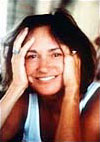 |
→ June 2004 Contents → Feature
|
Aftermath Introduction:
An Existential Choice June 2004
|
 |
|
The circumstances in which a person becomes a professional photographer are infinite and often legendary and as Ziyah Gafic is only 23 years old and already represents a myth in the world of photo reportage, together with the fact that he gets awards and recognition everywhere, makes him worth some reflection. I first met Ziyah Gafic at World Press Photo, an institution that I love profoundly because it helped me understand my work better and, above all, created a possibility to meet photographers in person.
In the hall of Felix Merits (now famous) in between the two projections, Paul Lowe introduced me with Ziyah: a face young and intense, a face that doesn't know western dullness and bore-international political situation and about literature.
I am impressed by his knowledge of history, of events and, for me; this represents an exciting guiding principle when working with a photographer. Gafic is different by nature from the great western photographers who went to work in Bosnia with commitment and courage, sacrificing money, carrier, time, private life and who have left a documentation of great importance, a portrayal on 5 years of war seen through the eyes of a Westerner, but who have often admitted to be devastated and powerless in front of this experience (let's not forget that the War has caused 250.000 dead people and 1,500.000 refuges); he is different because he sees all this with an extra eye, if you can say it like this, because he felt this experience on his own skin as a boy and after a few years he told us all about it to make us act politically and be an active part in what we live.
"I heard the bullets whizzing and saw corpses being picked up, fortunately I was always only a few centimeters away, whenever I was going to school" tells Ziyah, and exactly during those years he meets the famous western photographers and sees how they work, but his choice to become a photographer is made as an existential choice. Ziyah has lived in a horror and he felt the consequences on his own skin, on his family, his friends, yet he chooses to act politically to change the situation, to bring back dignity and identity to Bosnia. The war is finished but the consequences of war continue. He decides to get a degree in literature but in the same time starts to photograph for a weekly magazine. His understanding of the western world (he speaks English and Italian perfectly) make him learn quickly about the mechanisms which function in the international newspaper market. In his first documentary works which got many awards, he tells us about his family right after the War, about the discovery of common graves and the identification of corpses.
Many photographers have confronted this topic but, in my opinion, Gafic uses a surprisingly new language in pursuing a classical composition.
His photographs seem to be here to stay in the huge world of photography production thanks to his courage to use color and medium format (very powerful in portraying interiors and details) and to his extraordinary effort to treat photography as a singular element which can be valid on its own but which finds its strength and stunning beauty in the series of pictures which create a story.
His pictures are put in sequence with the utmost attention.
I'll make myself clear: in the two series "The Last Bosnian Village" and "Family Album", most of the photographs are so beautiful and soaked with menaning that they could exist autonomously as single poems, but when put in sequence they become a historical "portrait". The series "Quest for ID" is a masterpiece of its intensity and respect in recounting one of the most horrifying stories of this war: identification of corpses from the common graves. The photographs of the hanging laundry or the photo of the shoes represent condemnations much stronger than the pictures of the corpses themselves. Those pictures bring us back to numerous victims, to many sufferings, to the things that are no more. And, I think, for Bosnians this represents regret for the massacred generations, families broken up forever.
After doing pictures on his own country, Gafic continues to confirm his political and existential choice and decides to keep telling about consequences of other wars and in 2002 and the beginning of 2003 he finds himself in Palestine and Iraq. Even in these moments we can see how a photographer carries on his political and historical commitment to denounce by making new pictures, but with same ability even when found in another context. These are the works that are not yet completed but which reveal the growth of Ziyah who is very gifted in telling about daily life and in approaching people. The pretty Iraqi girl turning her eyes to the remains after the destruction invites us to keep on struggling because the things will also be changing for her.
I believe that very soon the western photography will be enriched, like is already happening in other creative fields, by the presence of photographers from former Yugoslavia and East European countries. Ziyah's compositions definitely remind us of painting, but what kind of painting? In some photographs (Last Bosnian Village) it's classical painting, but in some photographs of Palestine and of Iraq we recognize contemporary painting. New eyes, new ways of seeing are ready to tell us about the world, eyes which, like in this case, come from a life experience which expresses itself clearly and honestly free from the obstacles of ego and open to the history.
© Grazia Neri
|
|
Back to June 2004 Contents |
|